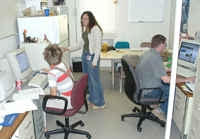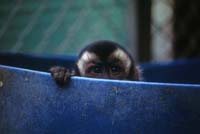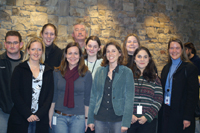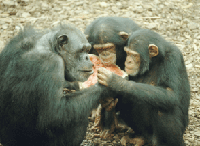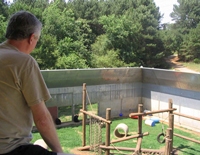
|
|
Leading a team of around twenty people (technicians, postdocs, graduate students, and undergraduates), I am never two days in a row at the same place. Living Links is where our offices are, and nearby we keep a colony of about 30 capuchin monkeys supervised by my technician, Marisa Hall. The monkeys are divided into two groups in indoor/outdoor areas. Most of the time, they just tumble around in their own enclosures, groom each other, and sometimes fight. I hear from Marisa the latest developments, which to an outsider must sound like a soap opera (such as "Bravo is in love with Sammie, but has to stay out of sight of the alpha male, Drella, to get anywhere with her" or "there are tensions so that bottom-ranking Emma gets beaten up"). Since I have known these monkeys for a long time, the stories carry meaning. I also hear how the latest testing is going, or help Marisa develop a protocol for new tests that we're planning. I look at videotapes to see for myself how the monkeys perform. The testing is usually done in a separate cage that we call the "test chamber." The monkeys enter the chamber, are kept there to solve a puzzle, share food with each other, or work on the computer touch-screen of Jen Pokorny, a student who wants to know how well the monkeys discriminate faces. After each test session, the monkeys are released back into their group. The lab has undergraduate student helpers, but the graduate students run their own projects, which they will tell me about if there's any news. There are so many details to attend to, and so many meetings, that the day is over before I know it. Other days, I am at the Psychology Department, where I teach, see more students, and do the administration of data and money matters. The only primates I see on those days are human. In class, I show tons of pictures and videos of nonhuman primates since I believe students can't understand primate behavior without seeing it for themselves. One or two days a week I drive my old Pontiac to the Yerkes Field Station, near Lawrenceville, which is about an hour outside of the city. It is a 117 acre piece of land on which we keep about two thousand primates, mostly rhesus monkeys. This station used to be in the middle of nowhere, but is now in the suburbs, separated from the neighborhood by a lake, a forest, and a high fence. The primates live in large groups in fenced-in, open-air compounds with lots of space and climbing structures. We work with two groups of chimpanzees that I have known for decades. Here again, I listen to my technician, Marietta Dindo, who fills me in on all of the developments, power struggles, and life-changing events. Peony's arthritis is acting up, Bjorn has a major gash from a fight, and Azalea is being weaned by her mom, and so on. A lot of the research here is observational. Marietta stands on the tower with a keyboard attached to a palm pilot and types in the behavior she sees, or graduate student, Amy Pollick, videotapes social interactions to see how the apes combine hand gestures with vocalizations. We also experiment with chimps, but since we cannot control them (they're stronger than we are) we are dependent on their willingness to be tested. Everything is on a volunteer basis. We have a special testing room into which we lure them by calling their names (we can even ask one chimp to fetch another, since they also know each other's names). Testing with chimps is slow: on some days no one wants to work with us (such as when the weather is splendid) whereas on other days they all try to come into the testing rooms, making lots of noise and preventing us from the one-on-one testing we prefer. Our tasks have to do with cooperation, reciprocity, imitation, mirror self-recognition, and so on. One project that is really taking off is cultural learning by Dr. Victoria Horner (of St. Andrews University) and Kristin Bonnie. See their special website. I have an office that overlooks one chimp compound. I have seen most of the adults grow up, so know them extremely well. They know me, too, of course, and never object to me being around, whereas strangers are received with mud balls against the window of my office, which they consider part of their territory. I watch the developments in the group, as there's always something going on, even on the laziest summer day. So, my days are not necessarily filled with hands-on primate work. I have watched monkeys and apes for literally thousands of hours, so only need to hear half a story or see a brief scene to know what's going on. I now leave the labor-intensive testing and observations mostly to others, but do want to be close to the scene and see my primate friends on a regular basis. |
||||||||||||||||||
